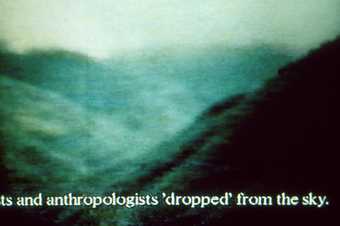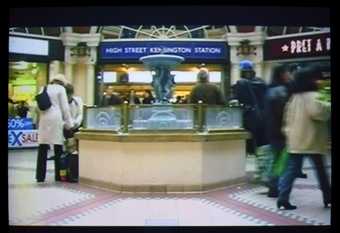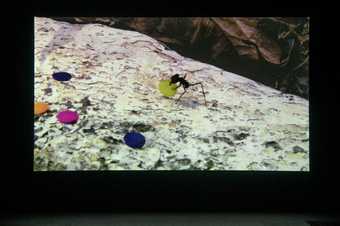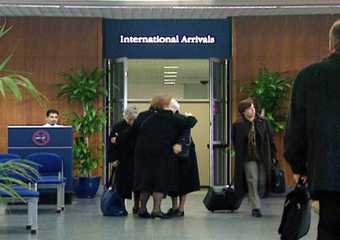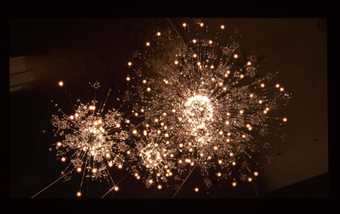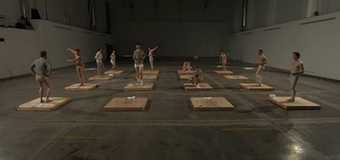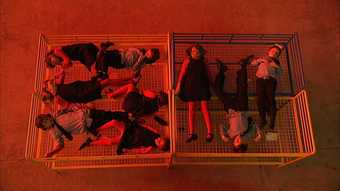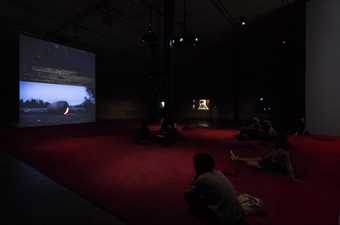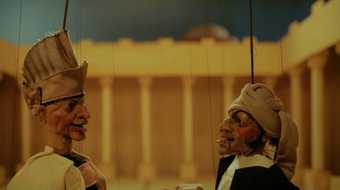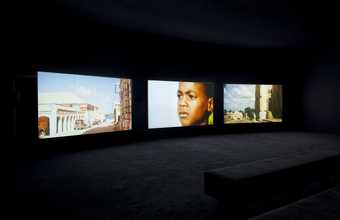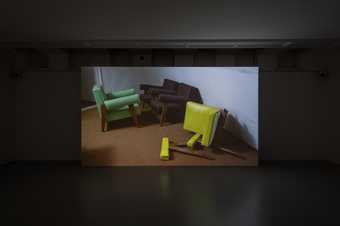
Not on display
- Artist
- Pierre Huyghe born 1962
- Medium
- Video, high definition, projection, colour and sound (surround) and digital print on paper
- Dimensions
- 21min, 41sec
- Collection
- Tate
- Acquisition
- Presented by Tate Members 2007
- Reference
- T12464
Summary
A Journey that wasn’t is a colour film that intersperses footage of an expedition to the Antarctic circle with shots of a concert held on an ice rink in Central Park, New York. Aside from a brief voice-over early in the film that provides a small amount of background information about the expedition, the rest of the work is not narrated. The Antarctic landscape is shown using wide shots that emphasise the vastness of the ocean, and the only elements of human life depicted are the boat and its crew, which are shown in both serene and extremely harsh conditions. The concert has a large audience and is elaborately staged, employing various lighting and smoke effects, with a set design that is based on the Antarctic scenes that appear intermittently throughout the film. The Antarctic sequences show the crew travelling and eventually disembarking on an island, where they walk across the ice and assemble some equipment. When they leave the area, an albino penguin walks near to these objects and the crew then returns and approaches the animal. Meanwhile, the concert sequences show a large orchestra playing very tense, often atonal music, and towards the end of the film a white animatronic penguin appears on the stage and the work finishes with a hologram of an island being projected over the ice rink and spinning around. The film is accompanied by a black and white inkjet print on white A4 paper that features handwritten text set within a standardised template. This document is a submission to the ‘UK Antarctic Place-Names Committee’ and proposes to name a place ‘Idleness Island’. Various pieces of information are included, such as the location of the island and the date of its discovery, and in a box titled ‘Reason for choice’ are written the words: ‘Idleness is the place of ideas, of something new appearing. In that case an albino penguin.’ The film is displayed in a dark, carpeted room, projected onto a screen that is mounted 500 mm from the wall, and the inkjet print is displayed in an adjacent gallery space. Some parts of the film were originally made using high definition digital video, but others were shot in Super 16 mm format and these sections subsequently converted into digital files by the artist.
This work was produced by the French artist Pierre Huyghe in 2005. Huyghe and his crew embarked upon the Antarctic expedition in February of that year, and the trip was prompted by the artist having learned that global warming had caused the Antarctic shelf to recede, opening up new areas of the ocean and access to uncharted islands. Huyghe had also heard a rumour that an elusive white animal lived in the region and one of the aims of the expedition was to find it. In his account of the trip Huyghe stated that after days of travelling, the crew came to an island that they thought was a likely location for the creature to be found and set up their equipment there, the white penguin eventually appearing after a wait of several days (see The Association of Freed Time, ‘El Diario del Fin del Mundo’, Artforum, vol.43, no.10, Summer 2005, pp.296–301). However, in 2005 the film’s director of photography Maryse Alberti gave a different account, stating that ‘The captain [of the ship] had seen a penguin on an island that’s an abandoned Chilean base with orange and black buildings. Argentina also has a base there and the British have a helipad ... We wrangled that poor animal to this sci-fi base and filmed it’ (quoted in Huyghe and Kaplan 2005, accessed 9 December 2014). The concert was held in October 2005 and jointly organised by the Public Art Fund and the Whitney Museum of American Art. The music was written by the composer Joshua Cody and inspired by Huyghe’s topographical map of the island.
The title of this work suggests that the expedition may not have taken place. The fact that this is untrue – that the crew did travel to the Antarctic – reflects Huyghe’s interest in the distinction between reality and fiction. The crew set out to find an animal known only through rumour and Alberti’s account of the trip suggests the circumstances of its appearance might be fictionalised in the film. Despite this, the naming of the place ‘Idleness Island’ and the reference to ‘something new appearing’ in its description also reinforces the myth that no interventions were made by the crew in finding the penguin. Furthermore, the penguin was also later turned into an animatronic figure and a theatrical copy of the island constructed for the concert, thus adding another layer of interpretation to an event that may have been fabricated in the first place. In 2004 Huyghe explained that his interest in documentary film lies the way that it can be used to create new realities, rather than presenting existing ones:
I occupy both sides of a divide: I build up a fiction and then I make a documentary of this fiction. The point is: we should invent reality before filming it.
(Huyghe in George Baker and Pierre Huyghe, ‘An Interview With Pierre Huyghe’, October, no.110, Autumn 2004, p.106.)
Discussing the relationship between the expedition and its representation in the film and concert in 2005, Huyghe said: ‘I’m interested in translation and movement and corruption from one world to another. I have doubts about exoticism, this fascination for bringing an “elsewhere” here, believing that “there” is “here”. Elsewhere always remains a story: to bring it back, you have to create an equivalent’ (Huyghe and Kaplan 2005, accessed 9 December 2014). In the expedition sequences in the film, the alien landscape of the Antarctic could be regarded as this exotic ‘elsewhere’. Yet the almost melodramatic effects of light and smoke in the concert version of the Antarctic give it a science-fiction-like appearance that can be seen to be Huyghe’s method of translating it into an ‘equivalent’ for the concert’s audience, encouraging them to question whether it is possible to recreate one location in another.
Further reading
Pierre Huyghe and Cheryl Kaplan, ‘The Legend of Two Islands: A Conversation Between Pierre Huyghe and Cheryl Kaplan’, DB Artmag, no.31, 27 October 2005, http://db-artmag.de/archiv/2005/e/7/1/385.html, accessed 9 December 2014.
Pierre Huyghe: Celebration Park, exhibition catalogue, Tate Modern, London 2006, pp.86, 124–5, reproduced pp.86, 88–102.
Amelia Barikin, Parallel Presents: The Art of Pierre Huyghe, Cambridge, Massachusetts 2012, pp.199–218, reproduced pp.181–2, 201–2, 206, 208–9, 211, 220.
David Hodge
December 2014
Supported by Christie’s.
Does this text contain inaccurate information or language that you feel we should improve or change? We would like to hear from you.
Explore
- emotions, concepts and ideas(16,416)
-
- formal qualities(12,454)
-
- photographic(4,673)
- recreational activities(2,836)
-
- travel / tourism(803)
- countries and continents(17,390)
-
- Antarctica(4)
- lifestyle and culture(10,247)
-
- exploration(29)
- ship, sailing(1,342)
You might like
-
Johan Grimonprez Korbarweng or Where is Your Helicopter
1992 -
Oliver Payne, Nick Relph The Essential Selection
2002 -
Rivane Neuenschwander, Cao Guimarães Quarta-Feira de Cinzas / Epilogue
2006 -
Mark Wallinger Threshold to the Kingdom
2000 -
Vong Phaophanit ‘All that’s solid melts into air (Karl Marx)’
2006 -
Willie Doherty Ghost Story
2007 -
Josiah McElheny Island Universe
2005–8 -
Jesse Aron Green Ärztliche Zimmergymnastik
2008 -
Kader Attia Oil and Sugar #2
2007 -
Dominique Gonzalez-Foerster Noreturn
2009 -
Apichatpong Weerasethakul Primitive
2009 -
Wael Shawky Cabaret Crusades: The Horror Show Files
2010 -
Sir John Akomfrah CBE The Unfinished Conversation
2012 -
Amie Siegel Provenance
2013 -
Cinthia Marcelle Leitmotif
2011

